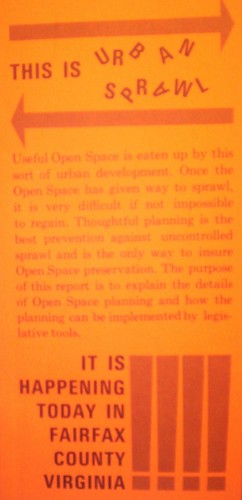Without the right planning "controls" you can't stop change: Loudoun County and rail service in Northern Virginia
Railroad station and visitors center, Culpeper, Virginia.
This week's City Paper has a nice story on the conflicts in Loudoun County over whether or not to participate in and fund the WMATA Silver Line extension beyond Dulles Airport further into the county. See "Planes, Trains, and Conspiracy Theories."
The article discusses the "dialectic" between "new" residents (including people who've lived in the county for decades), really residents connected to the metropolitan economy especially government-related contracting, and long-time residents who think the county is still rural and disconnected from "Washington", overlaid with a soupcon of anti-government, anti-tax fever.
Image from Virginia Virtucon blog.
The changes that Loudoun County residents think they will be warding off by not having subway stations there will happen regardless, because the subway is an indicator, not the cause of changes (well, it does cause changes, but that's a different blog entry), at least not the ones that they are concerned about, which have to do with the full integration of Loudoun County into the metropolitan economy and how that changes land use and refocuses it away from rural and agriculture towards a more suburban, deconcentrated but developed and gridlocked place.
Years ago, I came across a Fairfax County land use planning document circa 1962, called Vanishing Land, which made the point that if the county land use policy didn't get ahead of "leapfrog" development and institute better planning policies, that the county's land use would get out of control--sprawled. They were right.

Of course, these days people denigrate planners as not being conscious of those issues, although that wasn't the case. (Right: image from from The Vanishing Land: Proposals for Open Space Preservation, Fairfax County, Virginia, 1962.)
I happened to work for a time in Baltimore County, Maryland, which if not the first, is one of the first counties in the United States (1967), to create an urban growth boundary. This grew out of one of the nation's first environmentally oriented land use plans ("The Plan for the Streams and Valleys") by Ian McHarg.
But at the same time, it reflected a recognition that the county couldn't afford to extend water, sewer, and road infrastructure throughout the county.
The exact line of the URDL--the Urban Rural Demarcartion Line--changes a bit with each update of the master plan, but for the most part, half the county (not unlike Montgomery County's Agriculture Reserve area, although that was created in the late 1980s) has stayed rural.
The way they do it is by not extending "city water" service to the rural areas of the county.
If Loudoun County wants to preserve its rural character, it's going to need to better define it, and institute the kind of land controls--an urban rural growth boundary--that it thinks are crazy-left-progressive but at the heart in a way are really about conservation-conservatism.
At the same time, connecting the county better to the metropolitan area in terms of transit infrastructure helps it, frankly, at the expense of other areas of the region. I wrote about that last year, here "Short term vs. long term thinking: transit, the Washington Examiner, Fairfax/Loudoun Counties vs. DC," making the point that the Silver Line isn't so much about connecting Dulles Airport to the region by rail transit, as much as it is giving Fairfax and Loudoun Counties the ability to reposition their land use and real estate development paradigm for the 21st Century.
Now should the service be railroad rather than transit, probably.
But it's too late for that decision, because a thorough consideration of the best options didn't really occur. And frankly, it's the fault of not having comprehensive metropolitan transportation planning for the region. See "Silver Line Metro expansion a classic example of the need to have true regional transportation planning."
The Loudoun battle also gives us the opportunity to consider other (formerly?) exurban parts of Northern Virginia and their relationship to the core of the region, and how railroad service between these communities and the core changes this relationship and perceptions of distance.
The State of Virginia is "subsidizing" an expansion of reailroad service throughout the state and people are riding (Amtrak Virginia).
We were in Culpeper a couple of months ago, and Culpeper is one of the communities served by the railroad.
It struck me that just how the Metro-North Commuter Railroad in New York State and Connecticut, along with Amtrak, connect many "rural" communities to the region's economic heartland--New York City and related communities--expanded railroad service in Northern Virginia will over time do the same thing.
Besides the fact that Hudson, NY is bigger, the way it connects to New York City economically and through rail service isn't different from how formerly exurban parts of Northern Virginia will connect to the heart of the metropolitan economy through expansion of railroad and heavy rail transit.
Map of the Metro-North Railroad system (NY, CT, NJ--a couple of the lines start in NJ and are served by New Jersey Transit)
Labels: exurban development, land use planning, sustainable land use and resource planning, transportation planning, urban vs. suburban vs. rural






0 Comments:
Post a Comment
<< Home